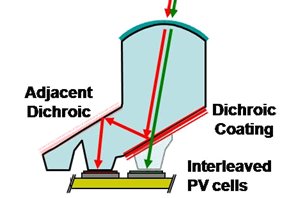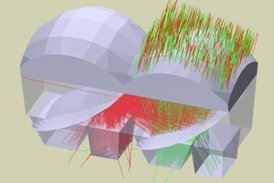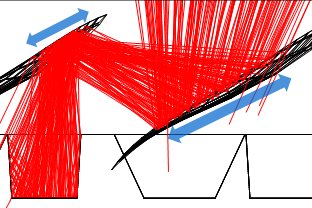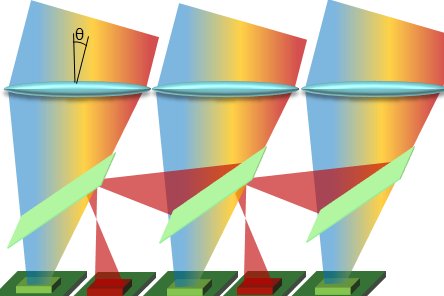Photonic Systems Integration
Laboratory
Multiband Solar Concentration: 10x Dichroic Spectral Splitting




The current trend towards high-efficiency photovoltaics involves multi-junction cells where several semiconductors are grown on top of one another creating a layered device with a broad spectral response. Fabrication is a difficult and expensive process that results in small area solar cells. An alternative approach uses dielectric mirrors to optically separate the incident light by reflecting certain spectral bands while transmitting others.
The simplest form of spectral splitting uses a lens to collect incoming sunlight and a dichroic beamsplitter prior to the focused spot. The dichroic divides the light into orthogonal spots, each incident on their respective PV cell. Practical packaging problems exist due to the vertical orientation of the second cell.
Our proposed solution considers spectral splitting from an array of repeated lens/dichroic systems, using two mirror reflections to orient multiband light onto a single plane. Light is reflected orthogonally as with the cube beamsplitter, however the divided light is incident on a second dichroic existing within the adjacent focusing system. Upon second illumination, the light is reflected again, now propagating parallel, but laterally shifted, to the light passed by the dichroic. This enables both PV cells to be interleaved on a common circuit board, simplifying packaging and thermal management by using a single heat sink for all cells.
A 10x low concentration system was designed using non-sequential ray tracing to collect light from a 40x16 degree field of view with >85% optical efficiency. The result is a rather unique dielectric microoptic which can be molded and assembled into large arrays. The shaped of the dichroic reflector and tapered sidewalls help channel the incident solar radiation with a 60% greater field than a paraxial lens equivelant.
Additional Information:
J. H. Karp and J. E. Ford, “Multiband solar concentrator using transmissive dichroic beamsplitting,” Proc. SPIE 7043, 70430F1-8 (2008).
Presentations: